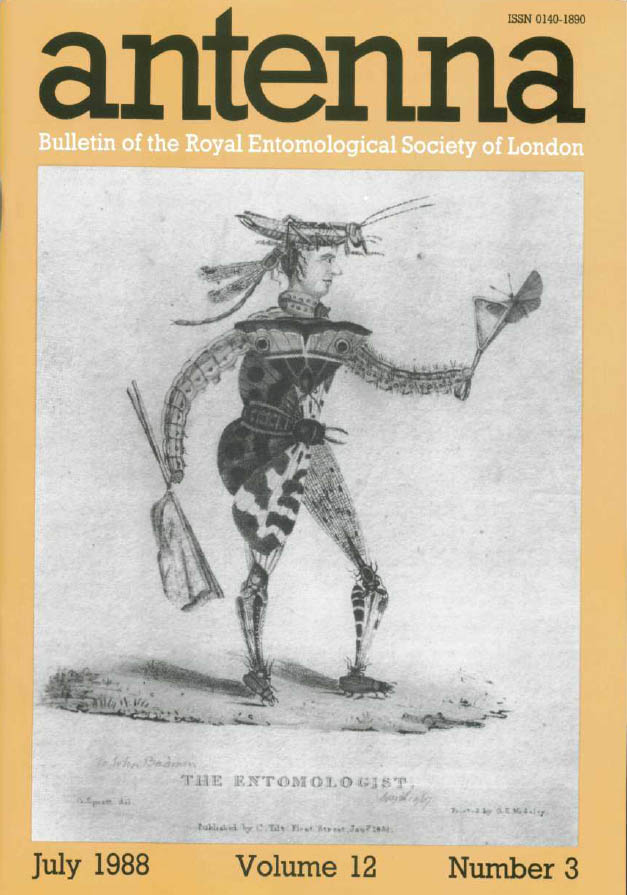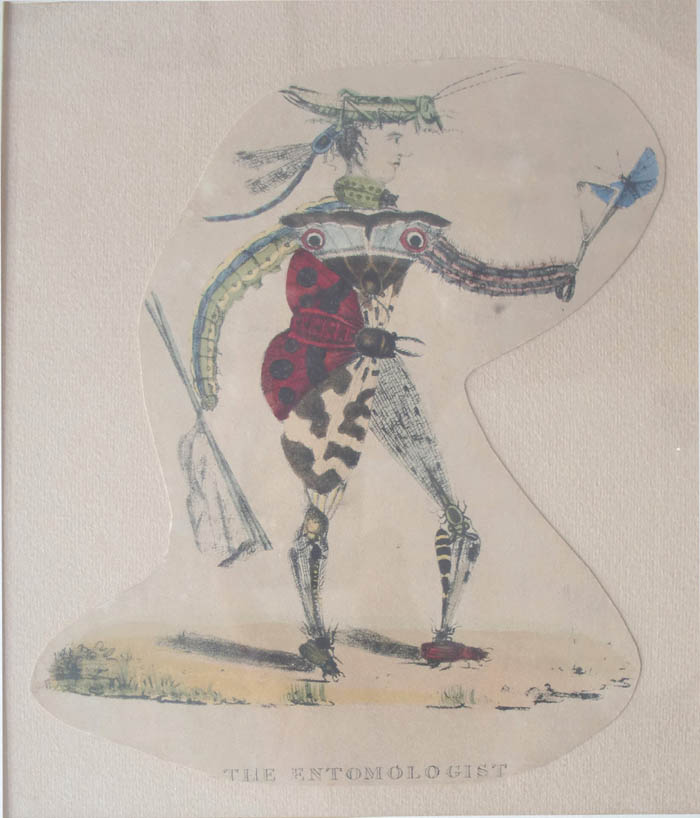| Home ::
Museum ::
Bibliothek ::
Sonstiges ::
Entomologist |
| „ The other 'Entomologist' “ Unter den Beständen an alten, zum Teil unidentifizierten Drucken, Tafeln und Aquarellen in der Bibliothek des MWM konnte unter der Inventar-Nr. N/13 eine bemerkenswerte Entdeckung gemacht werden: ein gedrucktes Exemplar des „The Entomologist“, ausgeführt von G. SPRATT, gedruckt von G.E. MADELY und editiert von C. TILT, Fleet Street, London, Januar 1830. Der Entomologist stellt einen Insektensammler dar, der nicht gezeichnet, sondern ausschließlich aus Teilen von Insekten zusammengesetzt ist. 14 Körperteile von Insekten verschiedener Ordnungen ergeben einen stehenden Menschen, der mit Hilfe einer zu seiner Zeit üblichen Insektenklappe einen Schmetterling fängt.  Über dieses Kuriosum gibt es eine Veröffentlichung aus der Feder von John BADMIN in Antenna 12(3):86 (July 1988), dem Mitteilungsblatt der Royal Entomological Society of London. Auf dem Titelblatt dieses Heftes ist der Druck in Schwarzweiß abgebildet. Die Veröffentlichung sei im Folgenden wiedergegeben: The Other 'Entomologist' I can well remember the day I was asked to join the Editorial Committee of the Entomologist, the new Royal Entomological Society Journal on palaearctic entomology. I was delighted. I was also amused , and remarked to my wife how appropriate it was in view of the other 'Entomologist' who has been our companion for many years. The other Entomologist as the plate shows is a 19th Century print of an insect collector. What is so interesting about the print is the clever way in which the artist, Mr G. Spratt, has portrayed an entomologist composed entirely of different insects. Apart from his face, the entomologist has a beetle neck, geometrid shoulders, Caterpillar arms, a tigermoth body (most probably Arctia caja), damselfly and wasp legs and matching beetle shoes. His head attire for want of a better description, consists of a curious assemblage of a grasshopper, a beetle and a damselfly! In all, a total of fourteen insects from five different orders. To complete the picture the entomologist is attempting to capture a bluebutterfly with a net that was obviously designed for much smaller insects. When I showed the print to members of the Editorial Committee they suggested that I should try and find out more about the artist and his painting. Dr Mike Wilson and Mrs Pam Gilbert, head of library Services in the British Museum (Natural History), failed to find any trace of the print in the Museum archives. A request for Information at the last Verrall Supper drew a similar response. The original, if it exists, was executed by Mr G. Spratt, printed by G.E. Madely and published by C. Tilt of Fleet Street in January 1830. I acquired the print as a 21st birthday present from my uncle, S.R. Badmin, a water colour artist, who knowing of my interest in insects had bought it in London a year or so previously. Despite his long career in the art world my uncle has never come across another copy of the print. I would be grateful to hear from fellows of the existence of any other copies and any information about the artist. As a postcript I can say that the Entomologist (the Journal that is) has already notched up its first success. A post Editorial discussion with Dr John Noyes led me to send a spider ectoparasite to him that I was thinking of discarding. It turned out to be a pimplinid wasp, Polysphincta neilseni Roman, new to Britain. JOHN BADMIN Coppice Place, SELLING, Kent ME13 9RP. Nach einer kurzen Korrespondenz zwischen dem Autoren und WITT erschienen ein Jahr später folgende Artikel: More about 'The Entomologist' I wish to thank Fellows for their replies to my request for more Information about 'The Entomologist' print (see Antenna 12(3): 96).Mr A. Harman from Essex and Dr T. Witt from Munich wrote to say that they are both proud owners. Dr Witt received his as a birthday present after his mother had spotted a print in an antique shop on the island of Jersey last year. Dr R. Driscoll of Norwich Museum remembered seeing prints representing various 'professions', including 'The Entomologist', in the Library of the Wellcome Institute for the History of Medicine several years ago. The present librarian, Mr W. Schupbach, has been very helpful and tells me that the artist, Mr Spratt, had drawn "The Itinerant Apothecary' in similar style, presumably as one of a series on the 'professions'. He states that the artist may have painted the originals in water-colours which were then transferred to stone and printed as lithographs, or he may have drawn them directly on stone. He also notes that Mr Spratt did not invent this way of depicting 'professions' or people's interests. It dates back to the sixteenth Century at least when Guiseppe Arcimoldo (1572-1593), a Milanese painter, used a similar concept in oil paintings which now hang in Vienna and elsewhere. JOHN BADMIN Coppice Place SELLING KentME139RP (Mr E.W. Classey also wrote on this matter in Antenna 12 (4): 151. Ed.) (The mention of a water-colour original moves me to suggest that Fellows skilled in the use of this medium might try their hand at recreating the putative original. I cannot offer publication in these pages but at least a display in The Society's Rooms and honourable mention in Antenna could be anticipated. On the other hand, I feel that Mr Spratt's inventive skills may have been greater than his entomological knowledge. The 'cervical' beetle looks most suspicious! Clearly some artistic licence must be permitted in the colouring — or what about something on the same lines using your own selection of insects? Finally, may I suggest that John 'missed' an order in his tally of 14 insects and five Orders. I think that 'The Entomologist's' left thigh is not an odonate but a neuropteran, probably a myrmeleontid. J.A.B.) The 'Entomologist' and Colleagues Thumbing through earlier proceedings of the entomological societies, I have just come across two further references to the print of the "Entomologist" depicted on the cover of Antenna 12(3). In 1941 a print was exhibited at the Annual Exhibition of the "South London" by S.O. Castle Russell of Highcliffe, Hants (now Dorset). It was described by him in all its colourful detail in Proc.Trans. S. Lond. ent. nat. Hist. Soc. 1941- 42: 31. He stated there that the cartoon was one of three produced by G. Spratt in 1830, and that he was in possession of a copy of each: 'The other two are entitled the "Conchologist" in which the figure is made up of Shells, and the "Mineralogist" in which the figure is made up of various minerals. A copy was also exhibited at a meeting of our own Society in October 1912 (Proc.ent.Soc.Lond. 1912; xciii). The exhibitor was a Mr Turner -probably the well-known H.J. Turner, then a Council member living in southeast London. The account, subtitled 'A curious entomological picture', is brief and provides no new information. DAVID B. SHIRT 42 Herlington Orton Malborne PETERBOROUGH PE2 OPW Abschließend sei hier die Beschreibung des Druckes in Proc. Trans. S. Lond. ent. nat. Hist. Soc. 1941-42: 31 wiedergegeben: RECORDS AND FULL DESCRIPTIONS OF VARIETIES AND ABERRATIONS Exhibited at the Annual Exhibition of the South London Entomological Society Compiled by S.G. CASTLE RUSSELL and HY.J. TURNER… MR. H. G. TUNSTALL.—Argynnis paphia, L. Three males, ……. [es folgen Bemerkungen über verschiedene Lepidoptera]….. and another from Ashtead larva, 15.6.39. He also showed a copy of an old cartoon entitled the " Entomologist." The figure was made up of wings, legs, bodies, etc., of various orders and of various stages. p.31: [Note by S.G. CASTLE RUSSELL] This cartoon is one of three published by C. Tilt, Fleet Street, January 1830. G. Spratt del. Printed by G. E. Madeley. The other two are entitled the " Conchologist " in which the figure is made up of shells, and the " Mineralogist " in which the figure is made up of various minerals. I possess a copy of each. The face (side view) is a pleasant youthful one, the only human element. The head is covered by a large grasshopper as a cap with extended forward antennae; at the back of the head is a long bodied dragonfly perched below the bent bind legs of the grasshopper and with half extended wings and curved abdomen. Covering where the ear should be is a large dark beetle. The neck is hidden by a larger beetle with a row of black spots on each side of the elytral suture. It has a black head coming below the chin of the face. The two arms are much magnified larvae, one dominated by green colour, the other by red and black. Each arm is extended, one forward the other half backward; each holds an old-fashioned implement of capture. The whole body is made up by a huge caja, right wing extending to the right knee, which is marked by a bronze beetle; the left wing reaches to the left shoulder but covered by a sort of Saturniid moth, which forms a V-shaped waistcoat over the chest. The left thigh and knee are formed by a nonde-script fly, whose body covers the knee. The portion below these limbs is formed by the black yellow-banded bodies of Hymenoptera simulating banded stockings and swathed in flimsy wings. These two limbs are settled on beetles for shoes, one a blue-black and the other a red-black beetle. The superscripture is : The Entomogist. Published by C. Tilt, Fleet Street, January 1830. G. Spratt del. Printed by G. E. Madeley.  Das Bild "The Entomologist" (Foto vom beschnittenen Original N/13 der Graphiksammlung des MWM) Von diesem kuriosen Druck existierten bis dato weder ein Exemplar noch irgendwelche Aufzeichnungen in der Bibliothek des Natural History Museums (= Brit. Museum, Nat. Hist.), London. Als Reaktion auf die obige Veröffentlichung von BADMIN (1988:86) meldete sich ein weiterer Besitzer eines Druckes (BADMIN, 1989:46). Ebenso findet die Existenz eines Exemplars in der „Library of the Wellcome Institute for the History of Medicine“ Erwähnung. Das hier vorliegende Exemplar (N/13 – MWM) ist nun das vierte, das neben den in den zitierten Texten erwähnten Exemplaren gegenwärtig existiert. Es wurde 1988 von der Mutter des Verfassers in einem Antiquariat auf der Kanalinsel Jersey erworben und diesem geschenkt. Im Gegensatz zu dem bei BADMIN (1988) abgebildeten ist das Exemplar im MWM leider beschnitten. Ebenso ging ein Hinweis von SHIRT (1989:46) auf die Existenz zweier weiterer Originale ein, die Oktober 1912 sowie 1941 ausgestellt worden waren, deren heutiger Verbleib jedoch unbekannt ist. Thomas J. WITT (F.R.E.S.), Oktober 2011 |